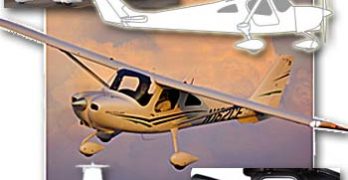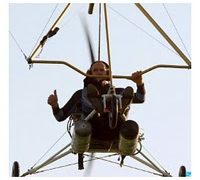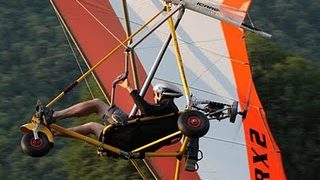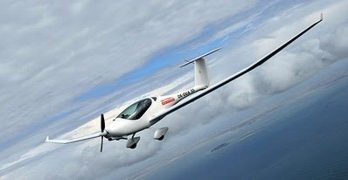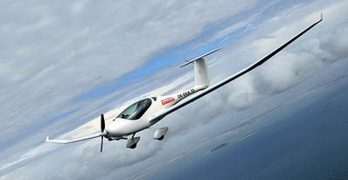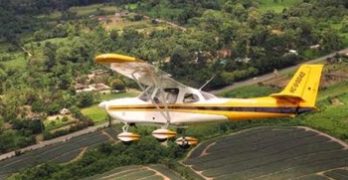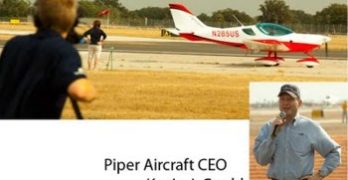It begins! The long awaited arrival of Cessna into the ranks of Special Light-Sport Aircraft has begun, with the first Shenyang-produced Skycatcher arriving in Wichita. The company reports taking more than 1,000 orders. At Oshkosh 2009, company officials said production would commence as originally planned in 2009 but that 2010 will be the year of substantial deliveries from their Chinese contract manufacturer. Soon, we’ll begin to see registered Skycatchers show up on our market share reports. *** Magazine reporters started to gain access for evaluation flights, though the first of those occurred on a slightly overweight prototype. Initial reports were positive, mirroring comments from Cessna managers who have gotten to fly the prototypes. Performance and payload are factors sure to be gauged by additional flight reviewers as production versions become available. So far, flights have occurred on the #2 prototype that was rebuilt after an incident following spin tests; that aircraft landed under parachute canopy and did not sustain major damage.
Search Results for : Flight Design
Not finding exactly what you expected? Try our advanced search option.
Select a manufacturer to go straight to all our content about that manufacturer.
Select an aircraft model to go straight to all our content about that model.
Fuel CellTrike Wins At Aero
French hang glider pilot and light sport innovator/entrepreneur G©rard Thevenot has been a visionary all his life. I’ve profiled him previously re his efforts to create alternative-powered sport aircraft. *** He’s been testing electric trikes for Yuneec, the China company that’s developing several commercial sky-breaking electric aircraft designs. *** And last fall he set an electric trike record for sustained power flight of 1 hour 16 min. *** Today comes word from Aero 2010 International Exhibition for General Aviation, the big European airshow, that Thevenot has been awarded the 2010 E-Flight Award for his hydrogen fuel cell-powered trike. *** His trike is one of three fuel-cell powered aircraft exhibiting at this year’s Aero show. *** A fuel cell is a power source that creates enough electricity to drive an electric motor, using, in Thevenot’s case, only hydrogen fuel and oxygen. *** The exhaust components?
Meanwhile, Back At the Electric Ranch…
The Creative Solutions Alliance (CSA) is a nonprofit organization, founded by Erik Lindbergh, grandson of Charles “Lucky Lindy” Lindbergh, that just announced his creation of the Lindbergh Electric Aircraft Prize (LEAP). *** In stirring language as quoted to AOPA’s Alton K. Marsh, Lindbergh says, “We are literally teaching the next generation to imagine and create their future.” *** The idea, as we’ve seen in the past with similar contests such as the Orteig Prize (1st Atlantic crossing won by Lindbergh) Kremer Prize (human powered flight – Gossamer Condor), and the X-Prize (1st private suborbital space flight), is to “promote the practical development of electric aircraft by recognizing specific advances in this emerging cleantech (sic) industry.” *** Prizes will be awarded for: *** Best Electric Aircraft: keyword in this category is practical, and it can be an Experimental, LSA or Certified aircraft. *** Best Electric Aircraft Sub-System: component systems that advance the field of electric aircraft *** Best Electric Aircraft Component Technology: Individual components such as batteries, motors, power electronics etc.
Meanwhile, Back At the Electric Ranch…
The Creative Solutions Alliance (CSA) is a nonprofit organization, founded by Erik Lindbergh, grandson of Charles “Lucky Lindy” Lindbergh, that just announced his creation of the Lindbergh Electric Aircraft Prize (LEAP). *** In stirring language as quoted to AOPA’s Alton K. Marsh, Lindbergh says, “We are literally teaching the next generation to imagine and create their future.” *** The idea, as we’ve seen in the past with similar contests such as the Orteig Prize (1st Atlantic crossing won by Lindbergh) Kremer Prize (human powered flight – Gossamer Condor), and the X-Prize (1st private suborbital space flight), is to “promote the practical development of electric aircraft by recognizing specific advances in this emerging cleantech (sic) industry.” *** Prizes will be awarded for: ** Best Electric Aircraft: keyword in this category is practical, and it can be an Experimental, LSA or Certified aircraft. ** Best Electric Aircraft Sub-System: component systems that advance the field of electric aircraft ** Best Electric Aircraft Component Technology: Individual components such as batteries, motors, power electronics, etc.
Spring Buzzzzz…
Everybody laments the high cost of LSA ownership: here’s an alternative…especially if you like true bugs-in-teeth aviating like our winged forefathers…uh, and foremothers of course…er, forepersons? Sheesh. Staying PC is so last week. *** Manfred Ruhmer, the German hang glider world champion and one-time distance record holder of 435 miles (current record is 444 mi.!), has been working on his own electric-powered trike – named the Icaro 2000 Pit-Trike. *** Chalk up that curious name to translation from the Italian. Maybe it grabs the air like a pit bull? Icaro’s price page calls it Nano Trike – take your pick! *** BTW, a “trike” is a wheeled undercarriage, powered by a pusher-prop powerplant, that allows a conventional foot-launched (or aero-towed) hang glider to fly under its own power. *** The trike unit without hang glider wing lists between $11,000 and $15,000 US, reports my pal Dan Johnson, before shipping, *** and you still have to add your own hang glider – another $3K to $6K.
Phoenix Motorglider To Debut at Sun ‘n Fun 2010?
Last year, I almost got to do a flight report on one of the most enjoyable airplanes I’ve ever flown: an Urban Air Lambada SLSA motorglider. *** Alas, before the magazine could schedule the story, two (not one, but two) Lambadas broke up in flight, both in very strong soaring conditions. *** The design was immediately suspect of course, though plenty of load tests on the Czech Republic design both before and after the incidents had failed to show any structural weakness. *** Both pilots used their onboard ballistic parachutes by the way, which saved both their lives. That’s yet another strong argument right there for onboard parachute systems: no way would they have survived otherwise. *** One breakup was evidently a case of pilot overspeeding – way overspeeding, and during 1500 fpm soaring conditions to boot. Yikes. The other is still under investigation but pilot error is suspect there too.
Phoenix Motorglider To Debut at Sun ‘n Fun 2010?
Last year, I almost got to do a flight report on one of the most enjoyable airplanes I’ve ever flown: an Urban Air Lambada SLSA motorglider. *** Alas, before the magazine could schedule the story, two (not one, but two) Lambadas broke up in flight, both in very strong soaring conditions. *** The design was immediately suspect of course, though plenty of load tests on the Czech Republic design both before and after the incidents had failed to show any structural weakness. *** Both pilots used their onboard ballistic parachutes by the way, which saved both their lives. That’s yet another strong argument right there for onboard parachute systems: no way would they have survived otherwise. *** One breakup was evidently a case of pilot overspeeding – way overspeeding, and during 1500 fpm soaring conditions to boot. Yikes. The other is still under investigation but pilot error is suspect there too.
In Praise of Skyhawks
I was stimulated to blathering by a couple comments on my 2-part post on Santa Monica Flyer’s Charles Thomson the other day. *** Thanks always for all comments: very helpful and thought-provoking. *** Comment from Anonymous: Bad rap for the 172 in general. It’s one of the safest airplanes to fly, and it has the track record to prove it. *** I like the Piper, but let’s give it a few years in the air and then compare it to a 172. *** Sounds a little like the arrogance of youth. You might want to be careful with that while you’re in the air. Another Anonymous said…Awesome looking plane! I want to come fly it. Good luck to you!! *** Thanks to both of you. Starting off, I never meant to give the impression Charles Thomson was bad-rapping the C-172. He was justifiably critical of the Skyhawk that broke in flight and delivered him directly to the scene of a nasty crash afterward.
American Eagle Flies East
Soon to be a part of the GA flight line at a quaint country strip in western Mass. is the American Eagle. *** It’s new home will be at *** Great Barrington Airport (GBR), typical of small airdromes throughout our great land with its 2,585-foot paved strip, flight training and repair stations, charter ops and a loyal cadre of hangar-flyin’ pilots, some of whom I met the other day when I dropped in to say “Hi.” *** The lovely airport is five minutes from the cultural mecca of Great Barrington, nestled in the Berkshire Hills, a great place to live and a draw for Gothamites (NYC) to the south and Bostonians to the east. *** The strip was converted from a potato field in the ’20s, (maybe that explains its appeal to those of us of the Irish persuasion.) *** One regular who’s flown out of GBR for decades, after I asked him when the new Eagle SLSA would arrive, shot back, partly in jest, “Whattya want one of them for?” *** Once I told him a bit more about the industry and my little corner of it, we had a good yak about things all pilots love to talk about, starting with airplanes and ending with…airplanes.
Enter the PiperSport!
Piper Aircraft’s Prez/CEO Kevin J. Gould made it official today at Sebring: the company has entered into a new, worldwide-exclusive distributor licensing agreement with Czech Sport Aircraft that will bring the SportCruiser to market – by April! – under the new name PiperSport. *** As I reported yesterday, Piper did not buy into the company as had been rumored. *** Piper representatives told me there will be some changes to the aircraft, such as refining control harmonies, to optimize its conformability to Piper’s long heritage of entry-level airplanes. *** But by and large, this is still the SportCruiser, which is a fine, Euro-proven design that is not only an excellent training airplane but most definitely a lot of fun to fly, and a dream to land. *** CEO Gould and other Piper personnel addressed a gathering of public and media to make the important announcement. *** Gould began his remarks by evoking the original Piper Cub, what he described as “one of the original ‘LSA’ aircraft of its time.” *** “Piper is entering what is undeniably one of the most exciting market segments in general aviation,” he continued.
- « Previous Page
- 1
- …
- 104
- 105
- 106
- 107
- 108
- …
- 147
- Next Page »


